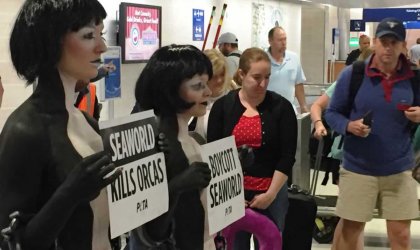Is SeaWorld bad? Compassionate people everywhere want to see animals treated humanely, and they have questions about places like SeaWorld. These days, the public has concerns about the complex needs of intelligent marine mammals—like orcas and other dolphins—and hates to see animals suffering in cramped tanks.

SeaWorld has worked hard to create the illusion of being a conservation organization that cares for happy, healthy marine animals. But years of hard-hitting PETA campaigns and the eye-opening documentary Blackfish have exposed the lies of this marine park chain.
So, is SeaWorld bad? Discover the truth by checking out the shocking facts below.
What Is SeaWorld? What Do Animals Endure There?
SeaWorld is a marine park chain that keeps animals in cramped concrete tanks at its facilities across the U.S. It builds its business on the suffering of intelligent, social animals.
Consider these facts:
- SeaWorld often confines dolphins, whales, and others with incompatible tankmates. The already stressed-out animals fight, which can result in fatal injuries.
- Staff members drug some animals in an attempt to relieve their constant frustration.
- Orcas at SeaWorld parks often break their teeth chewing on the metal bars and concrete walls of the tanks.

—Dr. Heather Rally
Where Is SeaWorld?
There are three SeaWorld parks in the U.S., and you should never visit them:
- California (SeaWorld San Diego)
- Florida (SeaWorld Orlando)
- Texas (SeaWorld San Antonio)
A former location, SeaWorld Ohio, closed in 2000. SeaWorld Abu Dhabi opened in 2023, and SeaWorld has two sister parks in Orlando, Discovery Cove and Aquatica Orlando, which both confine dolphins.
Buying SeaWorld Tickets Funds Animal Suffering, but You Can Help End It
Never visit SeaWorld or any other marine park. After you finish reading this post, be sure to tell your friends and family why they should stay away, too.

Is SeaWorld Bad or Good?
Don’t fall for the humane washing. No two ways around it—SeaWorld is bad. Among other horrors, here are just a few of the things it has done to animals:
- Employees drill out the inside of orcas’ worn and broken teeth, often without painkillers. This drilling keeps the teeth from becoming infected, but it does nothing to relieve the stress of being held in inadequate enclosures.
- SeaWorld trainers masturbated male orcas to collect sperm until it stopped breeding them in 2016, but it still does this to other dolphins. Workers sexually abuse the females by forcibly impregnating them, often drugging their victims to prevent them from resisting.
- SeaWorld still offers touch tanks and other animal “encounters,” falsely teaching kids that it’s OK to handle others against their will.
- In late 2018, a PETA veterinarian observed dolphins at all three SeaWorld parks. She found animals with open wounds and extensive scarring on their faces and bodies.
- According to a scathing article from The Travel, SeaWorld forces every employee to participate in its conspiracy to conceal its cruelty from the public.

How Many Orcas Have Died at SeaWorld?
More than 40 orcas have died at SeaWorld parks, and the death toll continues to climb. Here’s just one story:
An orca named Kasatka was imprisoned in a SeaWorld tank for nearly 40 years. She was abducted from her ocean home when she was only a year old. She died in August 2017, after reportedly having suffered from a bacterial lung infection since at least 2008. Lesions covered her ailing body before her death. In addition, her mate, Kotar, was killed after a pool gate closed on his head, fracturing his skull.
Have Other Animals Died at SeaWorld?
Orcas aren’t the only suffering animals who have died at SeaWorld:
- A blind walrus named Obie spent his life imprisoned in a cramped tank at SeaWorld San Diego. He appeared to suffer from deep psychological distress, as he would press his mouth against the tank’s glass and repeatedly regurgitate and re-swallow his food. This is a common neurotic behavior among confined animals, and it can cause serious health problems. He died in June 2015, after 18 years of suffering in confinement. Approximately 400 pinnipeds (seals, sea lions, and walruses) have died at SeaWorld parks.

- Captive dolphins routinely die prematurely of infectious diseases at marine parks. More than 500 dolphins and whales have died on SeaWorld’s watch.
- SeaWorld abducted a beluga whale named Nanuq from his home waters at the age of 6. He was used for artificial insemination. Workers removed him from the water and collected his sperm about 42 times. Six of his babies died at birth or shortly thereafter. After an interaction with another frustrated animal shattered his jaw, he died.

How Many Workers Have Died at Marine Parks Like SeaWorld?
In nature, orcas are almost never aggressive toward humans, but the constant stress of living in extreme captivity causes them to lash out.
SeaWorld’s incomplete incident log documents more than 100 instances of aggression from orcas at its parks as of 2011. These attacks often resulted in injuries to humans. Here are a few incidents:
- On February 21, 1991, Sealand of the Pacific trainer Keltie Byrne fell into a pool containing three orcas. One of them, Tilikum, pulled her to the bottom of the tank, and she ultimately drowned. It took Sealand employees two hours to recover her body from the orcas. She was the first of three humans who were killed due to Tilikum’s frustration from his forced confinement. All three orcas held at Sealand of the Pacific were later sold to SeaWorld.
- Years of stressful captivity caused Tilikum to exhibit further aggression toward humans, which ultimately cost two more lives. He killed Daniel P. Dukes in 1999, and in 2010 he killed Dawn Brancheau, scalping and dismembering her and breaking bones throughout her body before drowning her.
- In 2006, SeaWorld flew an orca calf named Keto and three other orca calves halfway around the world from San Diego to Loro Parque in Spain’s Canary Islands. A SeaWorld senior trainer was reportedly supervising the 2009 training session when Keto killed trainer Alexis Martínez. Since then, the company has tried to distance itself from Loro Parque, ultimately transferring ownership of the four orcas to the Spanish facility.

What Happened to SeaWorld After Blackfish?
Blackfish is a game-changing 2013 documentary that exposed some of SeaWorld’s most shocking abuse. Here’s a summary of what happened at this operation in the film’s wake:
- After the release of Blackfish, SeaWorld lost many corporate sponsors and scores of famous musicians canceled scheduled performances at its parks.
- As part of an aggressive response to criticism, the company went so far as to send a spy to PETA’s protests against its cruelty in order to incite illegal activity.
- In 2018, SeaWorld and its former CEO agreed to pay $5 million to settle charges that the company had misled investors about the negative impact that Blackfish was having on its business.
- After 33 years in extreme captivity, orca Tilikum, the star subject of Blackfish, died in a SeaWorld tank.
What’s Shamu’s Story? What Happened to Her?
In 1965, an orca named Shamu performed in the first-ever orca show at SeaWorld. Her story is another tragic tale of victimization, violence, and death:
- Shamu was kidnapped from her mother in the open ocean.
- During this violent event, her captors shot her mother with a harpoon—right in front of her.
- She died six years later from a uterine infection and blood poisoning.
- SeaWorld continued to name other orcas “Shamu” for years after her death.
More Shocking Facts About SeaWorld: Things You Might Not Know About Marine Park Cruelty
- Some of the orcas SeaWorld still imprisons were abducted from their homes in the ocean.
- With nowhere deep to dive, many animals trapped at SeaWorld can’t escape the hot rays of the sun. Workers at SeaWorld facilities have covered the skin of sunburned orcas with black zinc oxide to hide the burns and blisters from the public.
- In 2017, SeaWorld separated two bonded polar bears—Szenja and Snowflake—after they’d spent 20 years together, leaving Szenja without any other members of her species to interact with. She died two months later—likely of a broken heart. After this, reportedly neither Alaska nor Canada would give SeaWorld orphaned polar bear cubs.
- SeaWorld trainers often have no formal background in marine biology because the main purpose of the parks is to rake in money by putting on a “good show” for customers. Informing people about the natural lives, foraging behavior, and habitats of the animals held prisoner there is not the parks’ primary concern.
You Can Help Animals Trapped at SeaWorld Today
The question isn’t “Is SeaWorld bad?” It’s “Just how bad is SeaWorld, and what can I do about it?” The good news is that you can help animals at its vile facilities right now, no matter where you are. You can take action for orcas, other dolphins, and all animals held in marine parks by using your phone or computer. What are you waiting for? Here’s how you can get started:




